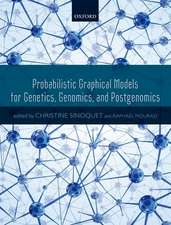Environmental DNA: For Biodiversity Research and Monitoring
Autor Pierre Taberlet, Aurélie Bonin, Lucie Zinger, Eric Coissacen Limba Engleză Paperback – 15 feb 2018
| Toate formatele și edițiile | Preț | Express |
|---|---|---|
| Paperback (1) | 348.36 lei 11-16 zile | +69.22 lei 6-12 zile |
| OUP OXFORD – 15 feb 2018 | 348.36 lei 11-16 zile | +69.22 lei 6-12 zile |
| Hardback (1) | 646.32 lei 32-37 zile | |
| OUP OXFORD – 15 feb 2018 | 646.32 lei 32-37 zile |
Preț: 348.36 lei
Preț vechi: 425.96 lei
-18% Nou
Puncte Express: 523
Preț estimativ în valută:
66.67€ • 69.51$ • 55.41£
66.67€ • 69.51$ • 55.41£
Carte disponibilă
Livrare economică 17-22 februarie
Livrare express 12-18 februarie pentru 79.21 lei
Preluare comenzi: 021 569.72.76
Specificații
ISBN-13: 9780198767282
ISBN-10: 0198767285
Pagini: 272
Ilustrații: over 60 illustrations
Dimensiuni: 190 x 248 x 13 mm
Greutate: 0.59 kg
Editura: OUP OXFORD
Colecția OUP Oxford
Locul publicării:Oxford, United Kingdom
ISBN-10: 0198767285
Pagini: 272
Ilustrații: over 60 illustrations
Dimensiuni: 190 x 248 x 13 mm
Greutate: 0.59 kg
Editura: OUP OXFORD
Colecția OUP Oxford
Locul publicării:Oxford, United Kingdom
Recenzii
This volume fills a much-needed gap, offering a gentle introduction into the field of environmental DNA, which will be especially useful for readers of minor to intermediate experience with environmental DNA.
An excellent instructional book or supplementary reading for any eDNA based classes...It is a timely and important addition to the field of molecular ecology, and will undoubtedly remain the go-to book on metabarcoding for several years.
This book is a timely overview of eDNA as a complimentary and non-invasive approach for investigating and monitoring biodiversity. The book is an ideal introduction to all ecologists looking to eDNA, but also speaks to the more experienced researchers in molecular ecology. Lastly, it provides textbook material for university courses around the world.
If you are contemplating moving into this topic, or just want to understand it better, do try and get your hands on a copy - something that might not be that easy just now as I understand the book has proved to be so popular that it is already having to be reprinted.
In a world faced with accelerating environmental change and loss of biodiversity, this book is a timely overview of eDNA as a complementary and noninvasive approach for investigating and monitoring biodiversity ... an ideal introduction to all ecologists looking to eDNA as a method of choice, but also speaks to the more experienced researchers in molecular ecology. Lastly, it provides textbook material for university courses around the world, where eDNA is continuously increasing in popularity.
An excellent instructional book or supplementary reading for any eDNA based classes...It is a timely and important addition to the field of molecular ecology, and will undoubtedly remain the go-to book on metabarcoding for several years.
This book is a timely overview of eDNA as a complimentary and non-invasive approach for investigating and monitoring biodiversity. The book is an ideal introduction to all ecologists looking to eDNA, but also speaks to the more experienced researchers in molecular ecology. Lastly, it provides textbook material for university courses around the world.
If you are contemplating moving into this topic, or just want to understand it better, do try and get your hands on a copy - something that might not be that easy just now as I understand the book has proved to be so popular that it is already having to be reprinted.
In a world faced with accelerating environmental change and loss of biodiversity, this book is a timely overview of eDNA as a complementary and noninvasive approach for investigating and monitoring biodiversity ... an ideal introduction to all ecologists looking to eDNA as a method of choice, but also speaks to the more experienced researchers in molecular ecology. Lastly, it provides textbook material for university courses around the world, where eDNA is continuously increasing in popularity.
Notă biografică
After teaching biology in high school for 10 years, Pierre Taberlet obtained his PhD in ecology in 1992 at the Université Grenoble Alpes. He is currently senior CNRS scientist in Laboratoire d'Ecologie Alpine at the Université Grenoble Alpes. He has been heavily involved in developing innovative molecular tools for tackling ecological questions. He was the recipient of the Molecular Ecology Prize in 2007 and is a member of the Norwegian Academy of Sciences and Letters (2005) and of Academia Europaea (2014).Aurélie Bonin obtained her PhD in genomics of local adaption in 2006. After various postdoctoral positions in population genomics and ecology, she is now a DNA metabarcoding project leader for the French AnaEE (Analysis and Experimentation on Ecosystems).Lucie Zinger obtained her PhD in microbial ecology in 2009. She is currently assistant professor at the Institut de Biologie de l'École Normale Supérieure in Paris. She is interested in the fields of biogeography, macroecology, community ecology, and microbial ecology, as well as eDNA-based techniques to uncover the diversity of elusive organisms. Her current work focuses on the distribution and assembly mechanisms of microorganisms in soils, oceans, plant leaves, and insects.Geneticist and bioinformatician, Eric Coissac obtained his PhD in genetics and genomics in 1996 at the Université Pierre et Marie Curie in Paris. He is currently associate professor at Université Grenoble Alpes in Laboratoire d'Écologie Alpine.


















